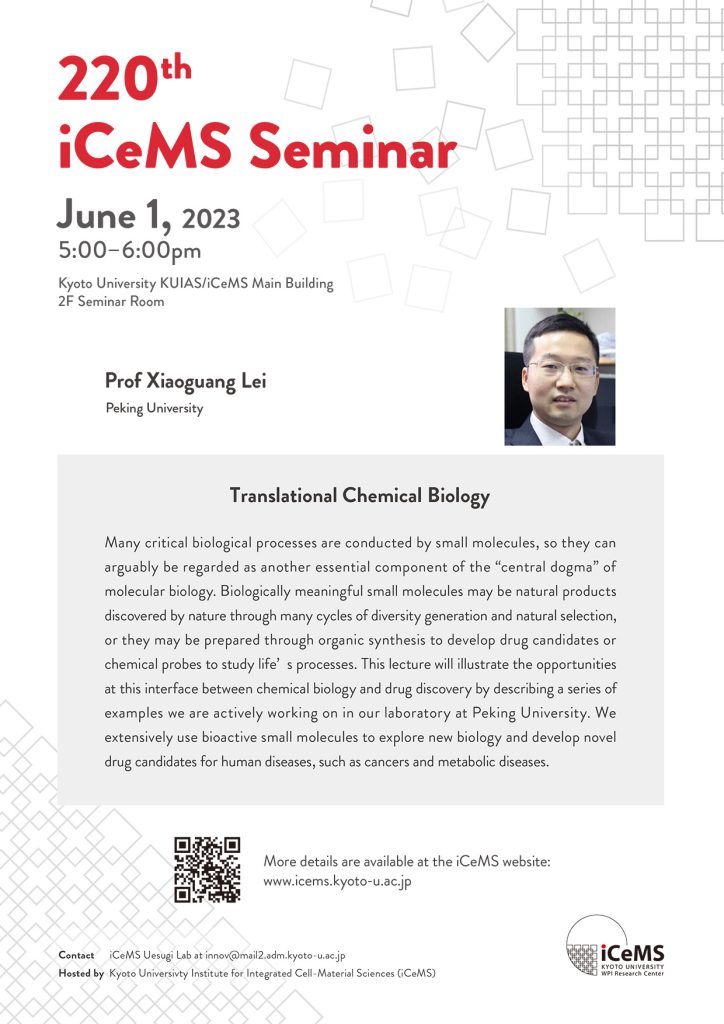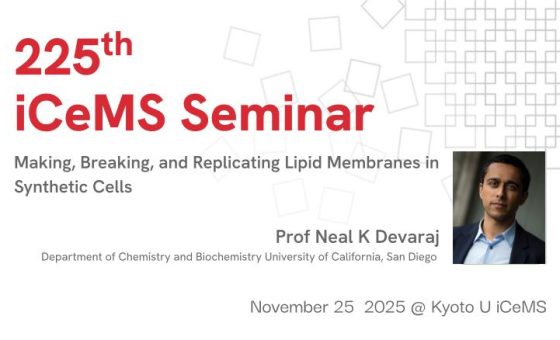【6/1開催】第220回 iCeMSセミナー:Xiaoguang Lei教授

Xiaoguang Lei教授
College of Chemistry, Peking-Tsinghua Center for Life Science, Peking University
Translational Chemical Biology
Many critical biological processes are conducted by small molecules, so they can arguably be regarded as another essential component of the “central dogma” of molecular biology. Biologically meaningful small molecules may be natural products discovered by nature through many cycles of diversity generation and natural selection, or they may be prepared through organic synthesis to develop drug candidates or chemical probes to study life’s processes. This lecture will illustrate the opportunities at this interface between chemical biology and drug discovery by describing a series of examples we are actively working on in our laboratory at Peking University. We extensively use bioactive small molecules to explore new biology and develop novel drug candidates for human diseases, such as cancers and metabolic diseases.
Key references:
[1] Wang et al, “Microbial-host-isozyme analyses reveal microbial DPP4 inhibition as a potential antidiabetic target” Science 2023, accepted
[2]Fan et al, “Structural basis of TRPV3 inhibition by an antagonist” Nature Chem. Biol. 2023, 19, 81
[3]Du et al, “A small-molecule cocktail promotes mammalian cardiomyocyte proliferation and heart regeneration” Cell Stem Cell 2022, 29, 545
[4]Zhang et al, “Hesperadin Is a Novel CaMKII-δ Inhibitor and Exerts Dual Functions to Both Protect Cardiac Ischemia/reperfusion Injury and Inhibit Tumor Growth” Circulation 2022, 145, 1154
[5]Wei et al, “Selective inhibition reveals the regulatory function of DYRK2 in protein synthesis and calcium entry” eLife 2022, 11: e77696
[6]Bai et al, “Dissecting Programmed Cell Death with Small Molecules” Acc. Chem. Res. 2020, 53, 1034
[7]Yue, et al, “Biomimetic synthesis of rhytidenone A and elucidation of the mode of action of the cytotoxic rhytidenone F” Angew. Chem. Int. Ed. 2020, 59, 4115
[8]Banerjee et al, “Inhibition of dual-specificity tyrosine phosphorylation-regulated kinase 2 perturbs 26S proteasome-addicted neoplastic progression” Proc. Natl Acad. Sci. USA 2019, 116, 24881
[9]Zhuang et al, “Chemoproteomic Profiling of Bile Acid Interacting Proteins” ACS Cent. Sci. 2017, 3, 501
[10]Dong et al, “Ainsliadimer A selectively inhibits IKKα/β by covalently binding a conserved cysteine” Nature Commun. 2015, 6, 6522
[11]Wang et al, “Small Molecule Activation of the TRAIL Receptor DR5 in Human Cancer Cells” Nature Chem. Biol. 2013, 9, 84
[12]Sun et al, “Mixed Lineage Kinase Domain-like Protein Mediates Necrosis Signaling Downstream of RIP3 Kinase” Cell 2012, 148, 213
- 日時
- 2023年6月1日(木)17:00〜18:00
- 場所
- 京都大学アイセムス本館2階 セミナールーム(A207)
- 参加費
- 無料 (事前登録不要)
- 言語
- 英語
- 主催
- 京都大学アイセムス(高等研究院 物質-細胞統合システム拠点)
- 問い合わせ先
- アイセムス 拠点長室:innov[at]mail2.adm.kyoto-u.ac.jp
当日は感染症の拡大予防の観点から、以下の点を遵守ください。
(1) 入館時の手指消毒
(2) (他部局・学外からの参加者の皆様)入館記録への記入
(3) 見学当日に、風邪様の症状や発熱、味覚・嗅覚異常など体調に異変がある場合の参加はご遠慮ください。
-560x340.jpg)






